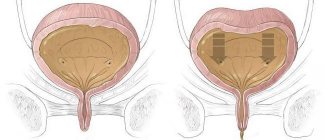Thousands of scientists around the world are trying to find a panacea for cancer. Unfortunately, these studies have not yet been successful, and all results are at the testing stage.
At the same time, millions of patients are waiting for a vaccine against this terrible disease, which annually claims the lives of a very young population.
Causes of the disease and risk factors
It is impossible to say exactly what causes a cancerous tumor , as this is a very complex issue.
There may be many reasons, but scientists were still able to establish connections between malignant pathology and some everyday phenomena.
The causes of bladder cancer in women may include the following factors:
- Smoking , which has a harmful effect on the chemical composition of urine. Long-term tobacco addiction weakens the mucous membrane of the organ and poisons the urinary contents.
- Chronic diseases of the urinary tract (cystitis, pyelonephritis), which provoke various neoplasms. This clinical condition can occur in the absence of treatment for urological pathologies.
- Harmful substances, carcinogens in factories, factories, workshops. This applies to women working in the construction, art, chemical, and textile industries. Some substances with which contact inevitably occurs have a high degree of oncogenicity. For example, aromatic amines, phthalates, benzene, aniline, etc.
- Taking antitumor drugs based on cyclophosphamide. The medicine has a harmful effect on the genitourinary area. Causes hemorrhagic cystitis, pathological changes in the cells and mucous layer of the bladder.
- Previously performed radiosurgery, radiation therapy . These procedures may have unpredictable consequences.
- A parasitic disease, schistomatosis , which also affects the genitourinary area. When it lasts for a long time and in advanced cases, it provokes cancer.
It is not known for certain what causes influence the development of malignant neoplasms.
Sometimes the patient’s medical history does not reveal any provoking factors for the disease.
About the first signs and diagnosis of bladder cancer in women in this video:
Risk factors include physiological criteria:
- age from 60 years;
- heredity, if relatives had genitourinary cancer;
- living in small industrial cities;
- long-term work in hazardous industries.
It is not necessary that in the presence of such conditions the oncological process will immediately develop. In any case, it is necessary to follow preventive measures and closely monitor your body.
People often ask: why do women have low white blood cells? You asked - we answer! A table of norms for biochemical blood tests in women is presented in this article.
You can learn about the causes of inflammation of the lymph nodes in the groin in women from our publication.
About the disease
Bladder cancer is a malignant disease in nature that originates in the transitional cells of the female body. Since these cells are classified by the term “urothelium,” the diagnosis of this organ is usually interpreted as urothelial carcinoma. Pathology is one of the ten most dangerous cancers.
Symptoms
Cancer is usually accompanied by symptoms that occur in many patients. However, neoplasms come in different types, so individual characteristics cannot be excluded.
At the initial stage, clinical manifestations may be completely absent. But in 90% of cases, a woman notices blood in her urine (hematuria).
These may be subtle blood clots or severe bleeding. Often hematuria may be the only manifestation of the disease, which should alert the woman.
Blood does not necessarily indicate cancer. This may be ordinary hemorrhagic cystitis or gynecological diseases. But they are usually detected by pronounced changes in urine tests.
The second most common symptom is pain in the lower abdomen and difficulty urinating. As the tumor progresses, the pain syndrome becomes chronic. It is not controlled by conventional antispasmodics, antibiotics and uroseptics.
The pain may radiate to the lower back, sacrum, legs and sides. Other dysuric abnormalities (frequent urination, pain when urinating) are also diagnosed. But everything depends on the location of the tumor.
As the tumor develops, new symptoms may appear and the general condition may worsen. The results of a general urine test may provide little information , since there will be no deviations from the reference values.
Microscopy of biomaterial usually reveals many red blood cells.
Cancer involves the following clinical manifestations:
- blood in the urine (hematuria), which occurs systematically or constantly;
- pain in the lower abdomen, in the lower back of varying degrees of intensity;
- urination disorders (frequent, small portions);
- pain during and/or after urination;
- urinary incontinence in severe cases;
- general weakness, apathy;
- anemia detected in a blood test;
- headache;
- low-grade fever (more than 37°C) in the later stages;
- lack of appetite.
About the symptoms and signs of bladder cancer in women and men in this video:
Causes of bladder cancer in women
As we mentioned above, the main risk factor is smoking. It increases the likelihood of disease by 4–7 times. Hence the most important preventive measure: if you suffer from this bad habit, you need to give it up as quickly as possible. Other risk factors:
- Certain Harmful Chemicals Risks are increased for women who work in the textile, leather, rubber, dyeing, printing and paint industries.
- Chronic bladder infections
- Neurological disorders If a woman is paralyzed in the lower part of her body, her bladder empties less well, urine stagnates in it and microorganisms multiply. Chronic inflammation increases the risk of cancer.
- Hereditary diseases, in particular Lynch syndrome (hereditary non-polyposis colorectal cancer).
Danger and psychological support
The main danger is that the tumor progresses quickly , so you cannot ignore pathological signs and put off going to the doctor.
The sooner treatment begins, the higher the chances of recovery without consequences. Any cancer has stages, and bladder tumors are highly curable if they present early.
If the malignant process has gone deep into the muscular layer of the organ, then surgical measures will be more radical. In this case, the patient’s general condition, as well as the quality of life, will deteriorate.
A prolonged absence of medical care is the main danger, as complications and deterioration of the condition inevitably arise.
Neoplasms come in different etiologies, and the international medical community has established a classification of their types. They all manifest themselves differently, so treatment must be strictly individual.
The most common type of tumor is transitional cell carcinoma , which is formed from the transitional epithelium of the organ. All other types of neoplasms are rare in women.
First, the cancer affects the mucous layer of the bladder, which can be cured without consequences. In this case, the neoplasm has not yet penetrated the muscle layer of the organ, but then irreversible processes are possible.
At the second stage , the malignant process penetrates the connective tissue and muscle layer. Then the neoplasm will spread to the fatty tissue and peri-vesical space.
The last stage is characterized by the development of oncology in neighboring organs (uterus, ovaries, vagina), metastases in the lymphatic system.
It is necessary to take medical measures as early as possible, since the risk of progression is very high, as with any cancer .
First, the doctor must carefully assess the patient's condition and the stage of the tumor in order to take adequate surgical measures.
Psychological support for the patient is very important , since very often patients are pessimistic and gloomy. Cancer is not a death sentence, so active efforts must be made to combat the disease.
The main thing is to be attentive to your body, evaluate all pathological changes and not let the disease take its course.
Psychotherapy will often be advisable to help a woman cope with depression and neurosis. Medicine has a wide range of ways to stabilize the condition.
Among the psychological support measures:
- psychotherapy sessions;
- drug treatment with antidepressants and other drugs;
- visiting and participating in communities aimed at providing psychological support to cancer patients;
- psychological conversation with relatives and friends of the patient;
- adequately informing the patient about his health condition and treatment;
- relaxation therapy, which includes balanced rest and relieving nervous tension through various means (music, sounds, etc.).
A stable psychological state is necessary to combat the disease. Depression and pessimism only worsen the clinical prognosis.
The main signs of thyroid disease in women are discussed in this material. Left lower back pain in women: causes and treatment are discussed in our article.
Stages of bladder cancer in women
The stage shows how far the malignant tumor has grown and spread in the body:
- Stage 0 – “cancer in situ.” Such a tumor is located in the upper layer of the mucous membrane and does not grow deep into the wall of the organ.
- Stage I The tumor has grown deeper, but still does not extend into the muscle layer of the wall.
- Stage II The tumor has grown into the muscle layer, but has not spread into the fatty tissue surrounding the bladder.
- Stage III The tumor has grown into fatty tissue and can spread to the uterus and regional lymph nodes.
- Stage IV Tumor cells have spread to the walls of the pelvis and abdomen, lymph nodes outside the pelvis, or there are distant metastases.
Which doctor to see, what examinations to undergo
The branch of medicine that deals with malignant diseases of the bladder is oncourology . If you have any suspicious symptoms that have not previously appeared, you should immediately consult a doctor.
A woman can contact the following specialists:
- urologist;
- oncourologist;
- oncologist;
- gynecologist.
You can simply visit a urologist at a clinic at your place of residence or at a commercial medical center. The doctor will issue a referral for a standard examination.
Based on the diagnostic results, it is necessary to find out whether the alarming symptoms are oncology or is it a common infectious inflammation.
A woman needs to visit a gynecologist to rule out diseases of the pelvic organs, which can cause similar symptoms. After a series of tests, the doctor will finally make a diagnosis and refer the patient to an oncology clinic/hospital.
Next, the patient’s clinical problem will be dealt with by specialized specialists - an oncologist or an oncourologist . To begin therapy and surgical measures, it is necessary to describe the condition of the tumor in detail.
A woman will have to undergo the following examinations and tests :
- general urine analysis and Nechiporenko test;
- urine analysis for microflora with sensitivity to antibiotics;
- ultrasound of the kidneys, bladder with Dopplerography, where you can visually see the tumor and its size;
- cytological examination of urine, which reveals atypical cancer cells;
- cystoscopy with biopsy of affected or suspicious areas of the organ;
- urine test for cancer markers UBC, CYFRA 21.1;
- MRI or CT scan of the lower urinary tract using a contrast agent;
- blood biochemistry to assess kidney function (creatinine, residual nitrogen, urea, uric acid);
- general blood analysis.
To study tumor formation, cystoscopy with biopsy is performed. The doctor uses a cystoscope to visually examine the walls of the bladder. The device is inserted through the woman's urethra under local anesthesia.
This is the “gold standard” of diagnosis, which allows you to see the exact location, size of the tumor, as well as its stage.
After all the tests and analyzes are completed, the doctor will make a final diagnosis . Next, preparations for surgery are carried out.
Diagnostics
If blood appears in the urine, a woman should consult a urologist. The doctor will prescribe laboratory and instrumental examination methods.
Laboratory methods
A general blood test will show signs of anemia, as the body loses blood in the urine, as well as leukocytosis and increased ESR. A biochemical blood test will show a decrease in the amount of proteins and an increase in glucose levels. The results of a coagulogram may indicate a tendency to increased blood clotting.
Instrumental methods
Inserting a camera through the urethra into the bladder (cystoscopy) allows you to examine the mucous membrane of the organ, identify a tumor, calculate its size and determine its growth pattern.
If a tumor is present, a biopsy is necessary. Cytological and histological examination of the biopsy will determine the morphology of the tumor and confirm or refute the diagnosis of a malignant tumor.
An ultrasound examination will show the presence or absence of metastasis in the lymph nodes. A type of ultrasound is transrectal ultrasound, in which an ultrasound probe is inserted into the rectum. Using this method, the doctor is able to assess the degree of proliferation of cancer cells in the bladder.
Cystography is the transurethral injection of a contrast agent into the bladder. The contrast in the X-ray image will completely repeat the outline of the walls of the organ, and from the image you can judge the shape and size of the tumor. X-ray and bone scintigraphy are necessary when identifying bone metastases.
The most modern and safe diagnostic methods remain CT and MRI. With their help, you can identify and evaluate a bladder tumor, the extent of the process and the condition of the lymph nodes.
During the diagnostic process, it is necessary to carry out a differential diagnosis with cystitis, cystolithiasis, tuberculous lesions, ulcers, and other pelvic tumors that could have spread to the bladder from neighboring organs.
If there is a concomitant pathology, consultation with a specialized specialist is necessary.
Therapy and its features
Treatment of the tumor is exclusively surgical , since conservative therapy is not so effective. However, it is used in case of infectious inflammation, which is often a complication of cystoscopy.
Rehabilitation will vary depending on the stage of the cancer and the type of tumor. Cancer in the early stages is best tolerated. But a more progressive malignant process can also be treated.
When a tumor develops, the following surgical measures are usually performed :
- transurethral resection (TUR);
- endovesical (transurethral) electrocoagulation;
- bladder resection;
- cystectomy (removal of the bladder and reproductive organs);
- lymph node dissection (removal of affected lymph nodes in case of metastases);
- cryosurgery;
- radiation therapy;
- chemotherapy;
- immunotherapy.
The attending physician decides which surgical intervention will be performed. TUR is a “gentle” surgical method for removing tumors.
There will be no incisions on the woman's body , since the operation is performed using a resectoscope and cystoscope, which are inserted into the woman's bladder through the urethra.
The tumor is removed under the influence of an electrical discharge. Then the doctor “cauterizes” the operated area to stop the bleeding. All this time the patient is under general anesthesia .
This operation is effective only when the malignant process has affected only the mucous layer of the organ and has not penetrated deeper. If the tumor has penetrated the muscle layer (invasive form), then TUR will be ineffective in this case.
Another non-radical method is endovesical (transurethral) electrocoagulation. It is similar to TUR, but this operation does not involve cauterization of blood vessels, so there is a high probability of heavy bleeding.
Cryosurgery is the insertion of a cooled probe with liquid nitrogen into an organ through the urethra. When exposed to very low temperatures, death (necrosis) of cancerous tissue occurs. This is a kind of “freezing” of the tumor.
A more radical method is bladder resection . This operation is performed in case of large tumors. The surgeon opens the organ cavity and cuts out the tumor.
This allows you to preserve the function of the bladder without removing it. But such surgery has many complications, including heavy blood loss.
After the operations, chemotherapeutic installation of the bladder and a series of Uro-BCG vaccines are carried out as an immunomodulator for speedy rehabilitation.
The most radical method is cystectomy or removal of the bladder along with the uterus and ovaries. This type of surgery is used in the final stages of cancer, when the tumor has penetrated the muscle layer of the organ. Sometimes cystectomy is performed if there is no improvement after surgical treatment.
This is a very difficult operation, as other reproductive organs are also removed. This is due to the special anatomical structure of the female genitourinary system.
After surgery, the issue of urine drainage is resolved . The following options are possible:
- attaching special urinal bags;
- diversion of the ureters into the large intestine;
- the formation of an artificial urinal from a segment of the intestine (cystoplasty), which literally replaces the bladder.
Such radical surgery has many complications. The patient needs to undergo regular examinations, as there is a high risk of kidney infection.
The video talks about treatment and chemotherapy for bladder cancer in women:
Types of tumors
All emerging tumors in the bladder are usually divided into 2 large categories:
- benign;
- malignant.
Tumors belonging to one type or another differ in their developmental characteristics, growth rate, effect on the body as a whole, and ability (or inability) to spread to neighboring tissues.
When identifying pathological cells, doctors first need to identify the nature of the tumor, since this determines the type of treatment and the level of risk to the patient’s life.
What not to do
If cancer is detected, you must strictly follow medical recommendations and adhere to a healthy lifestyle. This will help relieve the symptoms of cancer and not aggravate the clinical picture.
The organs of the genitourinary system react to the slightest errors in nutrition, so diet therapy is important in such situations.
The doctor explains in detail what should not be done if you have a cancerous tumor. A woman should avoid the following activities:
- Put off going to the doctor and deliberately make the disease worse.
- Take medications and medicines independently.
- Engage in strenuous physical activity and sports.
- Plan pregnancy if cancer occurs during reproductive age (extremely rare).
- Abuse hot, spicy foods.
- Smoking tobacco and drinking alcoholic beverages.
These simple measures must be followed to prevent the tumor from progressing too quickly. These actions create a favorable environment for its development and complications.
Treatment with folk remedies does not replace medical intervention , and therefore is not an alternative therapy.
In any case, self-medication is not acceptable , as this only worsens the patient’s condition and leads to tumor growth.
What sedatives can be taken during menopause in women? Details are in the next constructive article.
The main symptoms of female gynecological diseases are presented in this material.
Causes of neoplasms
The main reason for the appearance of uncontrolled tissue proliferation is cell mutation, which is expressed in the “breakdown” of the mechanism of growth and development. The following factors can cause such changes:
- ionizing radiation - this can be either the effect of radiation or receiving a dose of radiation in the treatment of certain diseases;
- prolonged contact with certain chemical elements;
- poor environmental situation (polluted air or water);
- the presence of toxins in the human body.
Formation of pathology and types
There are five degrees of development of pathology. The severity of symptoms, prognosis, and the possibility of treatment depend on the progress of cancer. The degree of development of pathology is the characteristics of the penetration of the disease deep into the organ, characterized by the affected layers of tissue.
- Zero stage. Abnormal cells can already be identified, but not a single layer of the organ has yet been affected. At this stage, papillary carcinoma is distinguished as a non-invasive type (it does not touch the walls and lymph nodes of the bladder, passing through the lumen) and an in situ type (the tumor has sprouted). The first form is benign, the second is malignant. The first can develop into the second.
- At the first stage, damage to the mucous and submucosal layer occurs.
- The second stage is characterized by the invasion of cancer cells into the muscles of the bladder, but the cancer does not grow into the tissue.
- At the third stage, the tumor grows into the lipid layer.
- On the fourth stage, active metastasis occurs. Cancer affects all nearby organs and the lymphatic system.
A histologist determines the degree of development of the disease. A piece of tissue is taken for analysis. The more primary the stage, the more favorable the prognosis.
Tumors at the initial stage of development are assigned a low grade of malignancy. It responds well to treatment and does not spread metastases. It is characterized by its small size and low growth rate. At the second stage, the tumor is already more dangerous and larger. On the third and fourth stages, metastasis occurs, which, of course, worsens the prognosis.
In addition to the degree of development, pathology is classified according to several other criteria. So, according to the type of spread, adenocarcinoma (a neoplasm from the glandular epithelium), transitional oncology (the transitional epithelium is affected), or infiltrative and squamous cell (the squamous epithelium is affected) are distinguished. The first type is less common than others, but develops faster and is less treatable. The second type occurs in more than half of all cases. The third type occurs in less than 10% of cases. A number of experts classify lymphoma (growth of leukocytes) as cancer of the genitourinary system.
In appearance, the tumor may resemble a polyp on a narrow stalk or be similar to an ulcer. According to the ability to isolate metastases, the pathology is classified into g1 (highly differentiated, that is, the cells are already deformed, but are still functioning), g2 (moderately differentiated, that is, the cells are completely affected), g3 (poorly differentiated, that is, the cells are completely deformed and no longer resemble the primary form ).
The World Health Organization has proposed a division based on malignancy and benignity:
- urothelial papilloma (benign neoplasm);
- papillary neoplasia (low grade);
- papillary carcinoma (low malignant potential);
- papillary carcinoma (high grade).
The first two types have favorable prospects for cure, the last two have a poor prognosis. The diagnosis is made taking into account all classifications. Treatment is always precise and comprehensive.
There is an opinion that people with light and very light skin are more susceptible to cancer. This judgment has so far received neither refutation nor confirmation.
Rehabilitation period
The postoperative period involves adjusting the type of diet and maintaining a healthy lifestyle to maintain the body's immune system. The foods you eat every day affect your bladder health.
Maintaining proper nutrition has a positive effect on the functioning of the organ. It is enough to follow a few recommendations:
- Maintaining water balance, since for the proper functioning of the urinary tract you should drink the daily amount of filtered water.
- Remove unhealthy foods such as fried foods, packaged juices and sweets, salty and sour foods and smoked foods from your daily diet.
- Give up bad habits forever: using tobacco products and alcoholic beverages.
- Avoid eating foods that irritate the bladder.
- Empty your bowels regularly.
- Avoid foods that cause frequent and excessive urination.
Doctors identify foods that have an adverse effect on the bladder:
- Food products containing citric acid. This includes citrus fruits, pineapples, and tomatoes. Fruits should be replaced with papaya, pears, watermelons and apricots, as these fruits have a low acidity level.
- Store-bought unnatural juices containing preservatives, glucose and fructose.
- Meat products rich in protein and acidic substances.
One of the main enemies is alcohol. Alcoholic drinks have a diuretic effect on the body, thereby causing the bladder to increase in size and stretch.
Alcohol irritates the mucous membrane and lining of the bladder. A large number of alcoholic drinks, in addition to alcohol, contain soda and fruit juice, which doubly irritates the bladder.
Classification
Stage classification of mucosal tumors is carried out in accordance with TNM. Bladder carcinoma is no exception. In addition to classifying the degree of malignancy of the tumor, histological examination is also carried out.
Since 2004, according to WHO criteria, the classification has only two options: high-grade and low-grade. Low-grade carcinomas are better differentiated and have a better prognosis than high-grade carcinomas with many atypia.
In German-speaking countries, a classification is being used that divides tumors from G1 to G3 depending on the degree of differentiation. G1 is a relatively atypical tumor, and G3 is a poorly differentiated tumor, and G2 falls between these two extremes
Symptoms of a tumor in men
In men, the symptoms are somewhat different from those that occur in women. Men with bladder tumors complain of:
- frequent urge to go to the toilet;
- severe pain during urination;
- nagging pain in the scrotum and pubic area.
This clinical picture is very similar to the manifestations of other diseases, including cystitis, urethritis and prostatitis. Many men put off visiting a doctor for a long time, believing that these symptoms are manifestations of the above diseases. This decision aggravates the situation and complicates further treatment.
Forecast
The prognosis of treatment depends entirely on the nature of the disease and the size of the tumor. Thus, many benign tumors do not require treatment, and the patient can live with them for many decades and not complain about their poor condition.
With malignant neoplasms the picture changes significantly. Diagnosis at stage 1 or 2 and proper treatment in 50-70% of cases give a good result and complete recovery. The prognosis for treatment of stages 3 and 4 is not so optimistic. At the same time, there are good treatment rates even at the last stage of cancer.
What can every person do to protect themselves as much as possible from this terrible disease? First of all, this means regular medical examinations and timely contacting the clinic when the first symptoms appear. In this way, it will be possible to recognize the disease in time and begin an active fight against it.
Therapy methods
If the suspicion of urothelial cancer has been confirmed during the preliminary examination, transurethral resection is performed first. The doctor uses an endoscope to take tissue samples. In some patients, the tumor can be completely removed by transurethral resection, and tumor cells cannot be found at the edges of the removed tissue.
To minimize the risk of tumor recurrence, resection should be performed 2-6 weeks after surgery. Also after surgery, local chemotherapy and instillation therapy are prescribed.
The choice of the appropriate treatment option, in addition to the exact location and stage of the tumor disease, depends on the individual patient's condition and is agreed with the attending physician.
Systemic chemotherapy
Some cytotoxic substances are active against urothelial carcinoma. Cisplatin, methotrexate, and doxorubicin/adriamycin were effective in achieving complete clinical remission in studies. Only combination therapy with several cytostatics showed further progress.
Systemic chemotherapy is a method of treating urothelial carcinoma
The objective remission rate increased to 70% (average 53%). Currently, complete remissions can be expected in a significant proportion of patients. The combination of methotrexate, vinblastine, adriamycin and cisplatin showed promise, which was confirmed in further studies. Several recent studies indicate that complete remission can now be achieved in an average of 22% of patients.
The likelihood that a patient will respond to chemotherapy can be predicted within certain limits. Metastases of different locations respond differently to M-VAC chemotherapy.
Even with bone metastases, which are typically said to have a poor response, complete remission has been reported in more than 20%. Thus, patients with exclusively pulmonary branching have a relatively favorable starting situation for systemic chemotherapy.
Adjuvant therapy
Patients with metastases to the lymph nodes represent a prognostically extremely unfavorable type of cancer. In recent studies, patients were randomized to a treatment group that was primarily treated and treated only when metastasis had occurred.
The studies had different treatment criteria and showed heterogeneous results. In only a small number of cases, a recent study showed a longer progression time in the group of patients receiving chemotherapy treatment. This study was stopped early, so further confirmation of these two-hospital data is needed in a multicenter study.
Side effects and risks
The cost of success of systemic chemotherapy is high: all methods demonstrate a relatively high level of side effects. Nausea, myelosuppression and other typical problems with systemic cytostasis are almost always encountered.
The incidence of sepsis is approximately 2%, and patient hospitalization time is just under a week per treatment cycle. This inevitably raises the question of the risk-benefit ratio for patients. It is necessary to decide on a case-by-case basis whether the patient is suitable for systemic chemotherapy.
If biological reserves are sufficient and the patient agrees, the indications should be quite generous, since there are no therapeutic alternatives to systemic chemotherapy. This leads to the challenge of improving the risk-benefit ratio for clinical trial therapy.
One of the few options available is to look for combinations of substances of equal effectiveness but with a lower incidence of side effects, thereby reducing patient burden and improving quality of life. Against this background, the etoposide-ifosfamide combination appears to have a more favorable side effect profile with similar therapeutic efficacy compared to previous phase II studies.
Nausea is a side effect
Systemic combination chemotherapy is the only treatment option for patients with metastatic urothelial carcinoma of the bladder, although it is less likely to cure.
Only patients who can achieve complete remission will benefit from therapy. This opportunity should not be taken away from suitable patients. Both questions about the overall benefit of adjuvant therapy and improved treatment options with reduced side effects can only be answered in multicenter studies.
Prevention
Scientists have not yet figured out the true causes of this disease. But doctors recommend taking preventive measures that can reduce the risk of cancer of the reproductive organs. These include:
- getting rid of tobacco and alcohol addiction;
- maintaining proper nutrition;
- introduction of physical activity into the daily regimen;
- maintaining mental health stability;
- maintaining water balance in the body.
It is recommended to perform an annual profile examination of internal organs. Most cancers are discovered incidentally in the early stages of progression. By detecting the pathology in advance, the patient has a chance for a full recovery.











